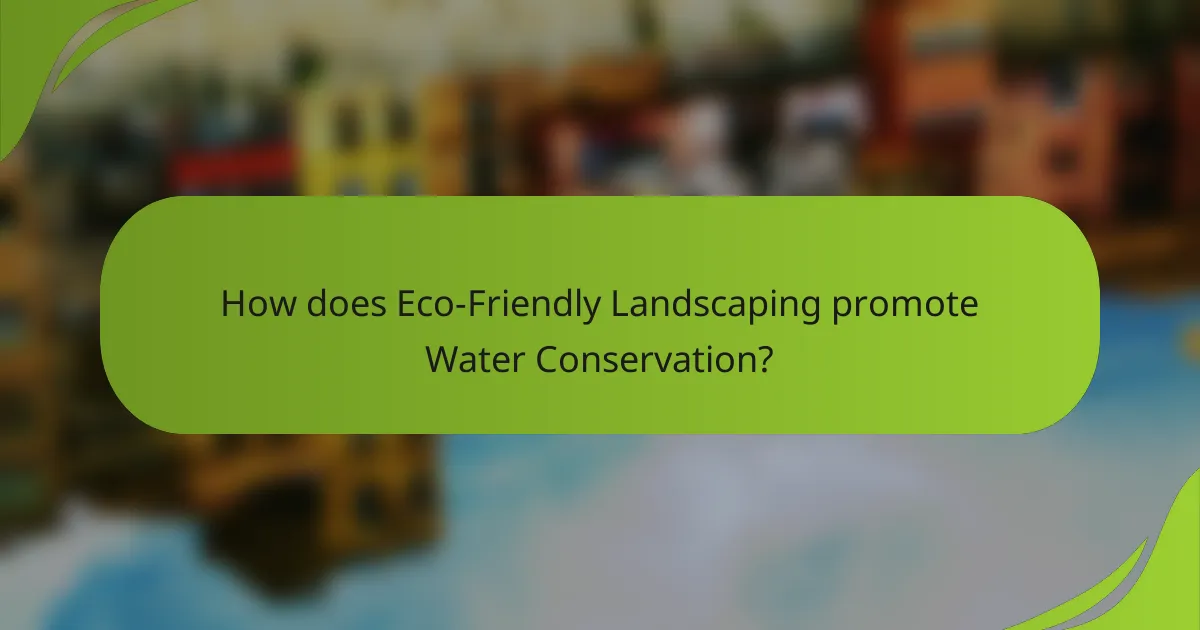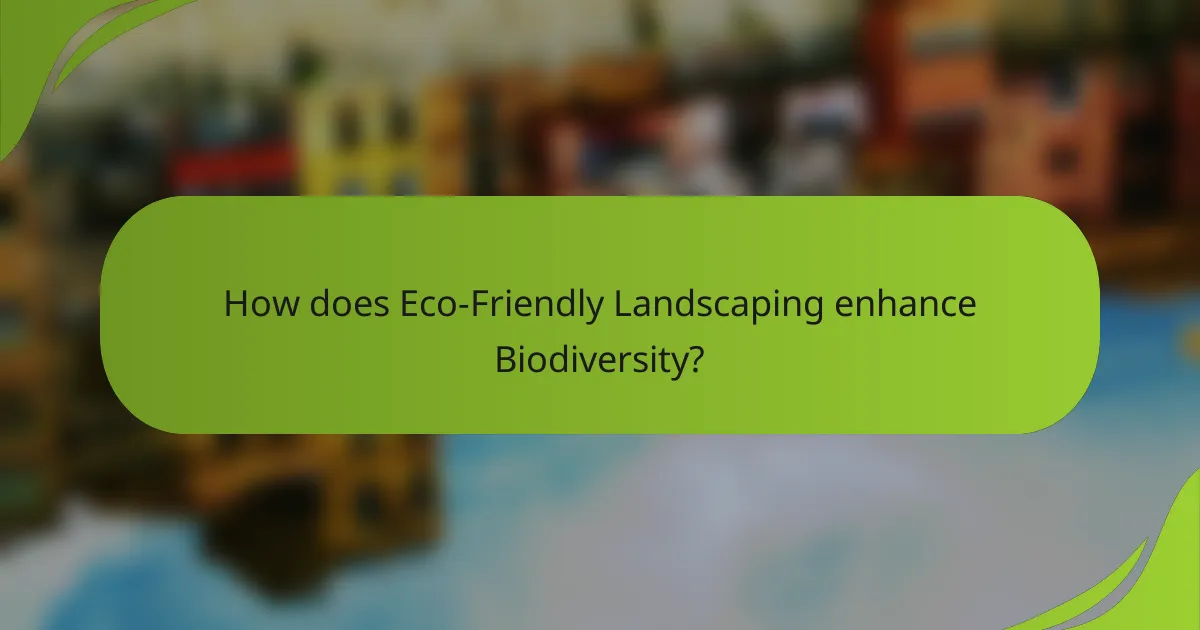Eco-friendly landscaping is a sustainable method for designing and maintaining outdoor spaces that prioritizes resource conservation, waste reduction, and biodiversity enhancement. This practice incorporates techniques such as using native plants, composting, rainwater harvesting, and organic gardening, all of which contribute to healthier ecosystems. By minimizing chemical use and promoting practices like xeriscaping and drip irrigation, eco-friendly landscaping significantly reduces water consumption and improves soil health. Additionally, it fosters biodiversity by creating habitats for local wildlife and supporting essential pollinators, ultimately leading to a more resilient and diverse environment.

What is Eco-Friendly Landscaping?
Eco-friendly landscaping is a sustainable approach to designing and maintaining outdoor spaces. It focuses on conservation of resources, reduction of waste, and enhancement of biodiversity. This practice often involves using native plants that require less water and maintenance. It also includes techniques such as composting, rainwater harvesting, and organic gardening. Additionally, eco-friendly landscaping minimizes chemical use, promoting healthier ecosystems. According to the U.S. Environmental Protection Agency, sustainable landscaping can significantly reduce water usage and improve soil health.
How does Eco-Friendly Landscaping differ from traditional landscaping?
Eco-Friendly Landscaping focuses on sustainability, while traditional landscaping often prioritizes aesthetics. Eco-Friendly methods utilize native plants that require less water and maintenance. Traditional landscaping may rely on non-native species that need more resources. Additionally, Eco-Friendly practices emphasize organic fertilizers and pest control. This reduces chemical runoff into local ecosystems. Traditional landscaping commonly uses synthetic products that can harm the environment. Eco-Friendly Landscaping also promotes water conservation techniques such as rain gardens and permeable paving. In contrast, traditional landscaping may lead to increased water waste through inefficient irrigation systems. Overall, Eco-Friendly Landscaping aims to create a balanced ecosystem, while traditional landscaping often prioritizes visual appeal.
What are the core principles of Eco-Friendly Landscaping?
The core principles of eco-friendly landscaping include sustainability, biodiversity, water conservation, and soil health. Sustainability focuses on using resources efficiently and minimizing waste. Biodiversity promotes the use of native plants to support local ecosystems. Water conservation involves implementing practices such as rain gardens and xeriscaping to reduce water usage. Soil health is maintained through organic practices, composting, and reducing chemical fertilizers. These principles contribute to creating landscapes that are environmentally friendly and resilient.
Why is Eco-Friendly Landscaping important for the environment?
Eco-friendly landscaping is important for the environment because it promotes sustainable practices that protect natural resources. This approach reduces water consumption through methods like xeriscaping, which uses drought-resistant plants. It also minimizes chemical use by favoring organic fertilizers and pest control. Furthermore, eco-friendly landscaping enhances biodiversity by providing habitats for local wildlife. Studies show that green spaces can improve air quality and reduce urban heat. According to the U.S. Environmental Protection Agency, sustainable landscaping practices can significantly lower stormwater runoff. This helps prevent water pollution and protects aquatic ecosystems. Overall, eco-friendly landscaping contributes to a healthier environment and supports ecological balance.
What techniques are used in Eco-Friendly Landscaping?
Eco-friendly landscaping employs techniques that promote sustainability and environmental health. Common techniques include xeriscaping, which reduces water usage by selecting drought-resistant plants. Native plant landscaping enhances local biodiversity and requires less maintenance. Organic gardening techniques use natural fertilizers and pest control methods. Rain gardens capture and filter stormwater, reducing runoff. Mulching conserves soil moisture and suppresses weeds. Green roofs provide insulation and habitat while improving air quality. These methods collectively contribute to a healthier ecosystem and lower environmental impact.
How can native plants enhance Eco-Friendly Landscaping?
Native plants enhance eco-friendly landscaping by promoting biodiversity and reducing maintenance needs. They are adapted to local climates and soils, requiring less water and fewer chemical inputs. This adaptation leads to lower irrigation costs and minimizes the need for fertilizers and pesticides. Research shows that native plants support local wildlife, including pollinators and birds, contributing to a balanced ecosystem. According to a study by the University of Florida, landscapes with native plants can reduce water usage by up to 50%. Additionally, native plants help prevent soil erosion and improve soil health. Their deep root systems enhance water infiltration and reduce runoff. Overall, incorporating native plants into landscaping fosters sustainability and ecological resilience.
What role does organic gardening play in Eco-Friendly Landscaping?
Organic gardening is fundamental to eco-friendly landscaping. It promotes soil health through natural methods. These methods include composting and crop rotation. Organic gardening avoids synthetic pesticides and fertilizers. This reduces chemical runoff into local waterways. Healthier soil supports diverse plant and animal life. Biodiversity is crucial for ecosystem stability. Studies show organic practices increase beneficial insect populations. This leads to natural pest control and reduced reliance on chemicals. Overall, organic gardening enhances sustainability in landscaping practices.

How does Eco-Friendly Landscaping promote Water Conservation?
Eco-friendly landscaping promotes water conservation by utilizing techniques that reduce water usage and enhance soil moisture retention. Native plants are often used, as they require less irrigation compared to non-native species. Rain gardens capture and absorb rainwater, minimizing runoff and allowing water to infiltrate the ground. Xeriscaping designs landscapes to reduce or eliminate the need for irrigation. Mulching retains soil moisture and reduces evaporation. Drip irrigation systems deliver water directly to plant roots, improving efficiency. According to the EPA, these practices can reduce landscape water use by up to 50%.
What strategies can be implemented for efficient water use?
Efficient water use can be achieved through various strategies. Implementing drought-resistant landscaping is one effective method. This involves selecting native plants that require less water. Utilizing mulch can help retain soil moisture and reduce evaporation. Installing drip irrigation systems delivers water directly to plant roots. Rainwater harvesting captures and stores rain for irrigation purposes. Regularly checking for leaks in pipes and hoses minimizes water waste. Grouping plants with similar water needs ensures efficient irrigation. Lastly, adjusting watering schedules based on weather conditions enhances conservation efforts. These strategies collectively contribute to sustainable water management in landscaping.
How do rain gardens contribute to water conservation?
Rain gardens contribute to water conservation by capturing and filtering stormwater runoff. They allow rainwater to infiltrate the soil, reducing surface runoff. This process helps recharge groundwater supplies. Additionally, rain gardens filter pollutants from the water, improving water quality. According to the EPA, rain gardens can reduce runoff by up to 90%. They also help prevent erosion and flooding in urban areas. By promoting native plant growth, they enhance biodiversity. Overall, rain gardens are effective tools for sustainable water management.
What is xeriscaping and how does it save water?
Xeriscaping is a landscaping method designed to reduce water use. It incorporates drought-resistant plants and efficient irrigation techniques. This approach minimizes the need for supplemental watering. Xeriscaping saves water by using native plants that thrive in local climates. These plants require less water than traditional landscaping. Additionally, xeriscaping often includes mulching and soil amendments. These practices help retain moisture in the soil. Research shows that xeriscaping can reduce outdoor water use by up to 50%. This makes it an effective strategy for water conservation.
Why is irrigation management crucial in Eco-Friendly Landscaping?
Irrigation management is crucial in eco-friendly landscaping because it optimizes water usage. Efficient irrigation reduces water waste and conserves this vital resource. Proper management ensures that plants receive the right amount of water, promoting healthy growth. It also minimizes runoff, which can lead to soil erosion and nutrient loss. According to the Environmental Protection Agency, efficient irrigation can reduce water usage by 30-50%. This conservation effort supports sustainable landscaping practices. Additionally, effective irrigation management can enhance biodiversity by creating a balanced ecosystem. It helps maintain soil health and supports various plant and animal species.
What are the benefits of drip irrigation systems?
Drip irrigation systems provide efficient water usage and reduce waste. They deliver water directly to the plant roots, minimizing evaporation and runoff. This targeted approach can lead to water savings of up to 50% compared to traditional methods. Drip irrigation also promotes healthier plant growth by ensuring consistent moisture levels. This system can reduce the risk of disease by keeping foliage dry. Additionally, it allows for precise application of fertilizers, enhancing nutrient uptake. Studies show that drip irrigation can increase crop yields significantly, making it beneficial for agricultural productivity.
How can smart irrigation technology improve water efficiency?
Smart irrigation technology can significantly improve water efficiency by utilizing data-driven methods to optimize water usage. It employs sensors to monitor soil moisture levels in real-time. This ensures that water is applied only when necessary, reducing waste. Additionally, smart irrigation systems can adjust watering schedules based on weather forecasts. This prevents overwatering during rainy periods. Research indicates that these systems can reduce water usage by up to 50%. A study by the University of California found that smart irrigation can lead to substantial water savings while maintaining healthy landscapes.

How does Eco-Friendly Landscaping enhance Biodiversity?
Eco-friendly landscaping enhances biodiversity by promoting native plant species. Native plants provide essential habitats for local wildlife. They support pollinators like bees and butterflies, which are crucial for ecosystem health. Additionally, eco-friendly practices reduce chemical use, minimizing harm to soil and water systems. This creates a healthier environment for various organisms. Research shows that landscapes with diverse plant life can support more wildlife species. A study by the University of Florida found that native gardens attracted 50% more bird species than traditional landscaping. Thus, eco-friendly landscaping directly contributes to increased biodiversity.
What practices support increased biodiversity in landscaping?
Practices that support increased biodiversity in landscaping include planting native species, creating diverse habitats, and reducing chemical use. Native plants provide food and shelter for local wildlife. Diverse habitats can include meadows, wetlands, and woodlands, which attract various species. Reducing chemical use minimizes harm to beneficial insects and soil organisms. Additionally, incorporating features like water gardens and compost areas enhances ecological interactions. Research indicates that landscapes with higher plant diversity support more animal species, promoting a balanced ecosystem.
How do pollinator gardens benefit local ecosystems?
Pollinator gardens enhance local ecosystems by providing essential habitats for bees, butterflies, and other pollinators. These gardens increase biodiversity by attracting a variety of species. They support the reproduction of flowering plants, which is crucial for food production. Pollinator gardens can improve soil health through the presence of diverse plant roots. Additionally, they contribute to water conservation by reducing runoff and promoting natural water absorption. Research shows that areas with pollinator gardens have higher pollinator populations, which leads to improved crop yields. A study by the University of California found that urban pollinator gardens significantly increase pollinator diversity and abundance.
What is the significance of creating wildlife habitats in gardens?
Creating wildlife habitats in gardens is significant for enhancing biodiversity. These habitats provide essential resources such as food, shelter, and breeding grounds for various species. Increased biodiversity supports ecosystem health and resilience. Gardens that incorporate native plants attract pollinators like bees and butterflies. This, in turn, aids in the pollination of crops and other plants. Furthermore, wildlife habitats can help control pests naturally, reducing the need for chemical pesticides. Studies show that gardens with diverse plant life can support a wider range of wildlife. For example, a study published in the journal “Biodiversity and Conservation” highlights that urban gardens can significantly contribute to local biodiversity. Thus, creating wildlife habitats in gardens is crucial for ecological balance and sustainability.
How can Eco-Friendly Landscaping practices be integrated into urban areas?
Eco-friendly landscaping practices can be integrated into urban areas through various methods. These methods include using native plants, which require less water and maintenance. Rain gardens can be installed to manage stormwater effectively. Permeable paving materials can reduce runoff and allow water to infiltrate the ground. Urban green spaces, like community gardens, can promote biodiversity and improve air quality. Incorporating green roofs can also enhance insulation and reduce urban heat. These practices collectively contribute to a sustainable urban environment. Studies show that urban green spaces can lower temperatures by up to 5 degrees Fahrenheit.
What role do community gardens play in enhancing urban biodiversity?
Community gardens play a significant role in enhancing urban biodiversity. They provide habitats for various species, including pollinators like bees and butterflies. These gardens often incorporate native plants, which support local wildlife and improve ecosystem health. Studies show that urban areas with community gardens have higher species richness compared to those without. Community gardens also promote soil health, which is vital for sustaining diverse plant and animal life. Additionally, they foster community engagement, leading to increased awareness of biodiversity issues. Overall, community gardens contribute positively to urban ecosystems by creating green spaces that support a variety of organisms.
How can green roofs contribute to sustainable urban environments?
Green roofs contribute to sustainable urban environments by improving air quality and reducing urban heat. They absorb carbon dioxide and release oxygen, enhancing urban air quality. Additionally, green roofs provide insulation, which lowers energy consumption for heating and cooling. They also manage stormwater by absorbing rain, reducing runoff and preventing flooding. Research indicates that green roofs can reduce surface temperatures by up to 40%. This cooling effect helps counteract the urban heat island phenomenon. Furthermore, they create habitats for various species, promoting urban biodiversity. Studies show that green roofs can support over 30 species of birds and numerous insects.
What are some practical tips for starting Eco-Friendly Landscaping?
Start eco-friendly landscaping by selecting native plants. Native plants require less water and maintenance. They also support local wildlife. Use organic mulch to retain moisture and suppress weeds. This reduces the need for chemical herbicides. Implement a rain garden to manage stormwater runoff. Rain gardens filter pollutants and recharge groundwater. Incorporate compost to enrich the soil naturally. Compost improves soil structure and fertility. Install a drip irrigation system to conserve water. Drip irrigation delivers water directly to plant roots. Finally, reduce lawn areas to minimize maintenance and water usage. Fewer lawns lead to less resource consumption.
How can homeowners begin implementing Eco-Friendly practices in their gardens?
Homeowners can begin implementing eco-friendly practices in their gardens by adopting sustainable gardening techniques. These techniques include composting organic waste to enrich soil naturally. Utilizing native plants reduces water usage and supports local wildlife. Implementing rainwater harvesting systems can conserve water and reduce runoff. Mulching gardens helps retain moisture and suppress weeds. Minimizing chemical fertilizers and pesticides promotes a healthier ecosystem. Creating habitats for beneficial insects enhances biodiversity. According to the Environmental Protection Agency, these practices can lead to a significant reduction in water and chemical use, benefiting both the environment and the homeowner’s garden.
What resources are available for further learning about Eco-Friendly Landscaping?
Books, online courses, and websites provide valuable resources for learning about eco-friendly landscaping. Notable books include “The Organic Gardener’s Handbook of Natural Pest and Disease Control” by Fern Marshall Bradley. Online platforms like Coursera and Udemy offer courses focused on sustainable landscaping practices. Websites such as the American Society of Landscape Architects and the National Wildlife Federation provide guidelines and articles. Local extension services often have workshops and materials on eco-friendly practices. These resources collectively enhance understanding and implementation of eco-friendly landscaping techniques.
Eco-Friendly Landscaping is a sustainable approach focused on designing and maintaining outdoor spaces that conserve resources, reduce waste, and enhance biodiversity. This article covers key techniques such as xeriscaping, rain gardens, and the use of native plants, which significantly improve water conservation and promote healthier ecosystems. It also outlines the principles of organic gardening, irrigation management, and the importance of creating wildlife habitats, all contributing to increased biodiversity in urban environments. Additionally, practical tips for homeowners and resources for further learning are provided to facilitate the implementation of eco-friendly practices in landscaping.